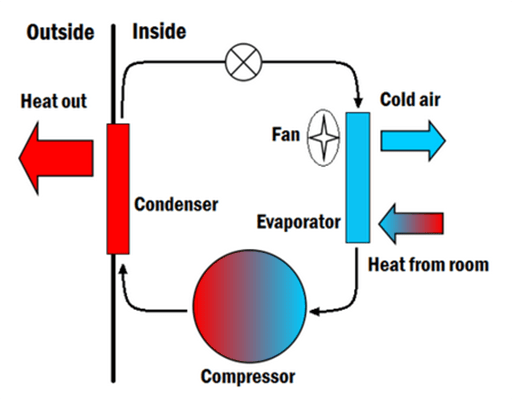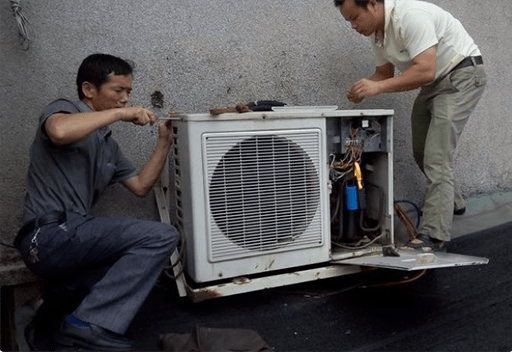
Figure 1: Somebody is setting the air conditioner.
Now it is summer with the burning sun outside, what we can not leave is the air conditioner. Although air conditioners have entered most families, power consumption is attracting people.
There is a saying that the energy-saving method of air conditioners is the dry mode, but some people figure that the dry mode will damage the compressor. So which opinion is true?
Do you know the difference between the cool mode and the dry mode? Is it genuine that the air conditioner consumes less energy if it’s in dry mode? And what is the better mode in summer?
Before answering these questions, we must first understand the working principle and internal structure of air conditioners.
Air Conditioner Working Principle
An air conditioner, as a "heat carrier", has several core components: a compressor, a heat exchanger (evaporator, condenser), and throttling devices.

Figure 2: The working principle of the air conditioner.
When the air conditioner is running, and the compressor starts, the refrigerant changes its form, and then it is conveyed in the pipeline and regulated by the throttling device. During this process, the refrigerant absorbs and dissipates heat on the heat exchanger (evaporator and condenser), so as to realize the heat exchange and adjust the indoor temperature.
What are Cool Mode and Dry Mode
After understanding the working principle of air conditioners, we can get the cool mode and dry mode easily.
In the cool mode, the surface temperature of the evaporator is reduced, the indoor fan is started, and the air is blown outwards to accelerate the flow of air so that the indoor temperature drops rapidly.
When the air conditioner is in the dry mode, it will be in a preset state, which is preset. And we can not adjust the air volume. For some air conditioners, the temperature can not even be adjusted.
At this time, the fan inhales, the indoor air condenses on the surface of the evaporator, and the humidity decreases. It can be seen that both the cool mode and the dry mode are based on the same principle.
In the refrigeration process, the hot air meets the cold evaporator, dropping the temperature. At the same time, the vapor in the hot air will also be condensed due to the low temperature, resulting in condensed water, which will flow to the water collecting tray and finally flow away from the condensed water pipe.
Therefore, when the cooling mode is turned on, the temperature drops and the room becomes dry.

Figure 3: Someone is using the remote control of the air conditioner.
During the dehumidification process, under the effect of the refrigerant and compressor, the surface temperature of the evaporator decreases, and the fan sucks the moist air into the low-temperature evaporator.
At the same time, the moisture in the humid air is condensed, collected to the water collecting tray, and drained away from the condensate pipe.
Therefore, the dry mode makes the room dry, as well as an obvious cool feeling.
Difference between Cool Mode and Dry Mode
The cooling mode and dry mode have the same working principle but perform in different ways.
In cool mode, the air conditioner cools down the room and the dehumidification is a supplement. In this case, you can adjust the temperature and wind speed. In order to achieve rapid refrigeration, the wind will blow out, so as to speed up the airflow.
On the other hand, in the cool mode, the refrigeration speed is much faster. The operation of the air conditioner compressor is mainly affected by the temperature change of the room.
In the dry mode, dehumidification is important, and the refrigeration effect is just a supplement. The air conditioner wind speed can not be adjusted. In order to better dry the room, the fan will only continue to suck in the air, but not blow out it, avoiding water evaporation caused by the airflow.
Therefore, in this mode, the cooling speed will be relatively low but the dehumidification effect will be better. The operation of the compressor is mainly infected by the temperature change on the surface of the evaporator.
Influence on the AC Compressor
In the dry mode, the compressor will change its working state according to the surface temperature of the evaporator. Due to the small surface area of the evaporator, the preset conditions can be realized quickly in the dry mode, the compressor of the evaporator will start and stop frequently.

Figure 4: Air conditioner compressors.
The frequent start and stop of the compressor means that the compressor is more prone to damage, is that true?
In fact, the dry mode will not damage the compressor of the air conditioner.
Dry Mode to Save Energy
In cool mode, the air conditioner compressor operates with high power. When the indoor temperature reaches the value we set and has been detected by the temperature sensor, the compressor will stop working. And the indoor temperature rises again, which has been detected by the temperature sensor, so the compressor will restart.
In the case of the frequency conversion air conditioner, the compressor will not stop, but by varying the frequency maintain the temperature in the room.
The cooling mode will make the compressor run for a long time, which means an increase in power consumption.
As mentioned above, when the dry mode is utilized, the operation of the air conditioner is no longer affected by the temperature of the room but depends on the temperature of the evaporator surface.
Compared to the space of the whole room, the area of the evaporator surface is smaller, so in the dry mode, the preset conditions can be reached faster, the compressor can stop faster, and the power consumption can be reduced.
Hence, in the perspective of power consumption, the dry mode is indeed more power saving.

Figure 5: The maintenance workers are repairing the compressor for the air conditioner.
Cool Mode Better in Summer
Since the dry mode will not damage the compressor of the air conditioner as well as more energy efficiency than the cool mode, is it encouraged to use dry mode in hot summer?
Exactly, the dry mode is more suitable for the hot and humid rainy seasons, while the cooling mode is more suitable for hot summer.
It’s because of the extremely high outdoor temperature in summer, using the cooling mode can quickly cool down space, as well as have a better refrigeration effect. But the dry mode would be slow to decrease the whole room temperature, and the cooling effect is not obvious.
There is no need to save electricity and give up comfort. In a word, from a comfortable point of view, you are more encouraged to use the cooling mode.
As for the wet and rainy weather, if the temperature is within 30℃, you are supposed to utilize the dry mode. In addition to saving power, it also makes people comfortable, because the cooling effect of the dry mode can meet our requirements at this time.
Related Info
Air Conditioner Refrigerant Leakage & SolutionsFour Methods to Maintain the Central Air Conditioner Compressor
Air Conditioner Compressor Not Starting - Causes & Solutions


